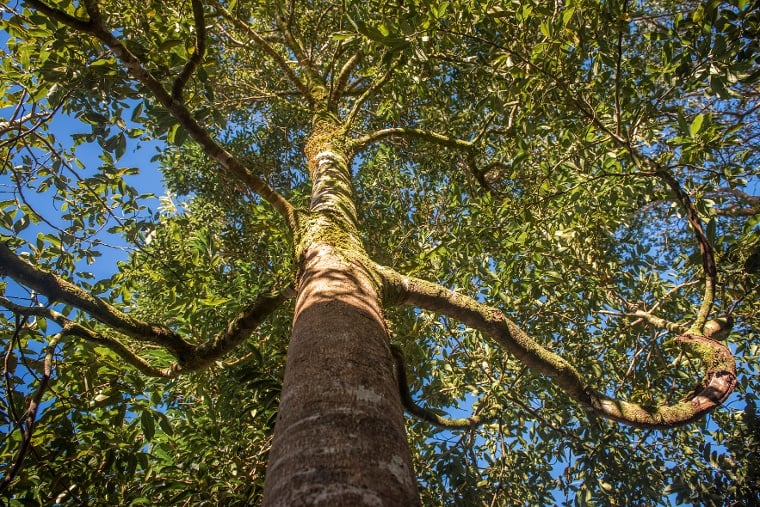The Trees of Monteverde
.jpg)
We recently did an article discussing the unique geography of Costa Rica, and how that geography has been a contributing factor to the country’s biodiversity. In the article, we also mentioned the wide variety of forests that grow here, thanks to the different elevations and microclimates that exist.
There is a well-known saying about not being able to see the forest for the trees, but in the case of Monteverde, the opposite is true… Sometimes, it’s easy to focus on the forests as a whole rather than diving into the types of trees that live there.
In this article, we are going to correct that by immersing ourselves in the living, breathing heart of Monteverde… or more accurately… it’s lungs. We have already learned about the Ocotea tree (or aguacate), so this time we will take a look at some of the most common species that can be found in our cloud forest.
What Makes a Cloud Forest?
A cloud forest forms when there are forests high enough up in the mountains that the trees themselves are often in the clouds- hence the name. This only occurs in tropical locations because, in other parts of the world, those same elevations have temperatures that are too cold for trees like these to survive. This explains why cloud forests are such a rare phenomenon (it is estimated that only 1% of the planet is covered with cloud forests).
When a forest grows at a high elevation in a tropical climate it results in unique conditions.
Flora and fauna that live there thrive in moisture and shade, leading to different species than the tall sun-seeking trees that will be found further down the mountain. It also means that the trees that do grow will be host to a wide variety of epiphytes such as bromeliads, lichen, and orchids. To learn more about orchids, check out our recent post on the subject here.
.jpg?width=800&height=480&name=Monteverde%20Costa%20Rica%20(3).jpg)
Some of these trees will host entire ecosystems within their branches, from the lichen to the bugs that eat them, to the animals that eat the bugs, and so on… so it is well worth looking up into the branches above you while you hike. These ecosystems may not be found anywhere else on earth.
Types of Trees
We aren’t going to list all of the trees that you will find in our cloud forests, for the simple reason that it would take an entire book! There are over 750 species of trees including 40-60 types of fruit trees and 60 types of avocado trees! But we will highlight a few of the most fascinating.
Ostrya guatemalensis
This small deciduous tree (also known as Ostrya Virginiana in the USA) can grow to a height of 59 feet and loses its leaves seasonally. Where trees in colder climates tend to do this in the fall, in tropical climates leaves are dropped before the onset of the dry season.
In ‘spring’ the tree will produce catkin-style flowers, meaning cylindrical flowers made up of a bunch of small flowers that hang from the branches. Pollinated flowers turn into nutlets and both the catkins and the nutlets are an important food source for species of birds, deer, and rabbits.
The tree trunks provide a resilient high-density hardwood which was often used in the making of longbows.
Aguacate Lauraceae
Also known as the Ocotea Tree this member of the Lauraceae family is commonly known as the wild avocado and is an important food source for many species, including the Resplendent Quetzal. They are broadleaf evergreen trees that can grow up to 130 feet in height.
-1.jpg?width=800&height=480&name=Monteverde%20Costa%20Rica%20(5)-1.jpg)
The family Lauraceae contains 2850 species including camphor (used medicinally for centuries) and the bay laurel/sweet laurel which is commonly used in cooking (bay leaves).
Myrsine coriacea
The Myrsine coriacea was widely harvested for its wood but is also an important pioneer species, used to help restore woodlands because they grow so quickly, reaching a height of 3-4 meters within 2 years and a maximum height of 6-12 meters.
They prefer moist soil, sunny climates, and elevations over 1500 meters, and will produce edible fruit year-round making them an important part of the forest food chain.
Quercus insignis
Quercus insignis is a species of white oak in the Beech family that prefers moist soil and thrives at elections of 1500-2500 meters. It grows up to 30 meters in height and produces large bur-like acorns every 5-10 years. It is slow-growing but has an extremely long life cycle, making it a stable habitat for many types of creatures.
.jpg?width=800&height=480&name=Monteverde%20Costa%20Rica%20(6).jpg)
However thanks to heavy forestation (and the fact that it takes a long time to grow) this species is currently on the endangered list.
Hymenaea
Hymenaea trees are part of the family Fabaceae, also commonly known as legumes. They are mostly large evergreen trees that will emerge above the forest canopy and grow to a height of 25 meters, although in some habitats they will also grow as shorter shrubby trees.
Hymenaea are also extremely useful, producing edible starchy fruits, bark that is often used to make canoes, leaves that can be used for tea, and dense timber that can be made into both furniture and ships. It also produces a hard resin that was used for varnish, incense, and cement, as well as amber.
The species Hymenaea courbaril in particular can play an important role in reforestation but is also being studied for its ability to capture greenhouse gasses.
Ficus (Fig)
While ficus trees like the iconic Strangler Fig will eventually kill the host tree on which it grows, ficus trees are a very important part of the forest ecosystem. Ficus are a keystone species that provide a food source for innumerable species including bats, monkeys, birds, and even ancient humans, and have been widely cultivated in many parts of the world.
They are easily identifiable thanks to the fact that the trees grow multiple thinner roots that start high in the canopy (usually in the branches of a host tree) and then extend down to take root around the host tree. Over time these roots/branches intertwine creating a uniquely intricate, lacy appearance.
The fig has a unique pollination method, which involves a symbiotic relationship with a certain species of wasp (known as the fig wasp). The wasps pollinate the trees while at the same time laying their own eggs.
-2.jpg?width=800&height=480&name=Monteverde%20Costa%20Rica%20(1)-2.jpg)
Cecropia
There are 61 recognized species of Cecropia, many of which are Myrmecophytes, meaning they have adapted a symbiotic relationship with ants, evolving traits that provide ants with food and shelter.
As an aggressive and fast-growing tree, the cecropia can also be a pioneer plant for reforestation. Their large, circular leaves, which resemble fingers are easy to identify and their structure, which has few leaves and widely spaced branches is very appealing to species like the sloth.
.jpg?width=800&height=480&name=Monteverde%20Costa%20Rica%20(4).jpg)
Most varieties of Cecropia grow 5-15 meters tall, but others can grow up to 40 meters in height. Full-grown trees can produce up to a million seeds and this prolificacy often makes it a keystone species in ecosystems that include frugivorous animals, such as birds, fruit bats, monkeys, and opossums. It can even feed species of fish when located near rivers or ponds.
Breathe Easier
And the species above are just a few of the many to be found in Monteverde!
There are so many ways in which the health of our forests provides the basis for all life on our planet, and it is inspiring to know that Costa Rica’s forests have been able to recover over the past 50 years thanks to widespread conservation efforts.
We now understand the importance of maintaining the well-being of those ecosystems. Our forests are the lungs of our planet, and the health of so many creatures is intertwined with the health of the forests including ours.
The planet can survive without us… but we can’t survive without it, and it is in the best interest of all to help Mother Nature do what she does best. Now that we know about (some of) the trees of Monteverde, may we all go forth and plant a tree so we can breathe a little easier.





-1.png)